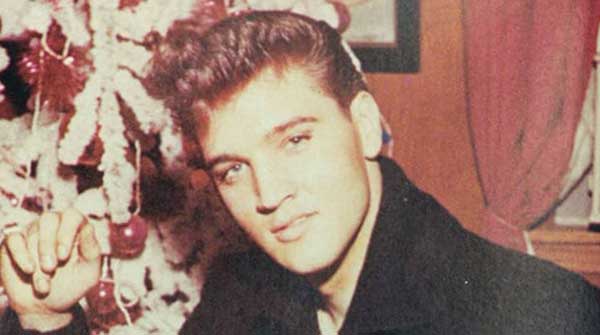The controversy and clever marketing behind Elvis Presley’s Rock ’n’ Roll Christmas album
 Teenagers in the 1950s couldn’t escape the music of their parents. Despite radio’s new-fangled Top 40 and the attendant infiltration of rock’ n’ roll, the sounds of the past were all around.
Teenagers in the 1950s couldn’t escape the music of their parents. Despite radio’s new-fangled Top 40 and the attendant infiltration of rock’ n’ roll, the sounds of the past were all around.
This was particularly the case for Christmas songs.
But things began to change in late October 1957, thanks to Elvis Presley announcing the impending arrival of “a rock’ n’ roll Christmas.” The setting was a San Francisco press conference and the reference pertained to the imminent release of Elvis’ Christmas Album.
Unsurprisingly, the media took the bait, waxing indignantly about the desecration of Christmas music. Even Time magazine got into the act. At the height of its influence, the magazine did one of its trademark putdowns, warning of the “most serious menace to Christmas since I Saw Mommy Kissing Santa Claus.”
 |
| Related Stories |
| Elvis Presley at 80
|
| Blue Christmas: How Elvis turned it into a seasonal classic
|
| Calling Elvis: When the King came home from the army
|
From the perspective of Elvis and his record company, the universe was unfolding as it should. Adults would profess shock and horror while teenagers would embrace the thrill of faux rebellion by flocking to the record stores.
It was an object lesson in clever marketing. Press the right buttons and people will step up to their assigned roles. All in all, it’s less expensive than a paid advertising launch.
The album had 12 tracks – four secular Christmas standards, two new rock’ n’ roll items with references to Santa, two traditional carols and four gospel recordings that Elvis had released in a different format earlier in the year.
The carols – O Little Town of Bethlehem and Silent Night – were performed in a conventional, straightforward fashion. And while the Presley voice may not have been to everyone’s taste, there was really nothing to get offended about.
Still, the idea of the guy nicknamed Elvis the Pelvis tackling such sacred texts was inherently offensive to many. You could say – as some did – that it bordered on sacrilege!
And although the carols were played straight, such wasn’t the case with the secular standards. Here Comes Santa Claus, for instance, had a rock’ n’ roll sensibility that you didn’t find in the Gene Autry original. Where the venerable Singing Cowboy had projected a hokey sense of down-home, Elvis brought a touch of street edginess.
However, it was the rendition of White Christmas that touched off a firestorm. Legend has it that the man who wrote the song, Irving Berlin, characterized the Elvis interpretation as a “profane parody” and wanted radio stations to ignore it. True or false, it’s a good story and indicative of the controversy the recording generated.
White Christmas had an iconic place in mid-20th-century popular culture. Introduced by Bing Crosby in the 1942 movie Holiday Inn, it struck a powerful wartime chord. For soldiers serving overseas and their families at home, it conveyed a sense of aspiration that was simultaneously melancholic and hopeful. And Crosby’s smooth, warm baritone was the perfect delivery vehicle.
Elvis, though, took a different approach. Inspired in part by a 1954 rhythm’ n’ blues adaptation, the Presley recording sounded nothing like the version people were accustomed to. It was white southern rock’ n’ roll, not mellifluous easy listening. To many, it was downright disrespectful.
Those of us inclined to a touch of cynicism will wonder just how much of the controversy was contrived.
Take, for example, the ostensible firing of Portland, Ore., disc jockey Al Priddy. While the hot news story was that Priddy lost his job for defying his radio station’s ban on Presley’s White Christmas, it’s since been suggested that the whole thing was a publicity stunt. Priddy, the revisionist version goes, was back on the air within a month and on the payroll during his absence.
Canadians weren’t immune.
A Calgary station described the album as “one of the most degrading things we have heard in some time,” and Toronto’s powerful CFRB turned thumbs down. Mind you, given CFRB’s natural demographic, one suspects that Elvis circa 1957 wasn’t a mainstay of its normal playlist.
For the first three weeks of December, Elvis’ Christmas Album sat at the very top of Billboard’s bestsellers. It was replaced by Bing Crosby’s Merry Christmas in the last album chart of the year but regained the top spot the following week.
Unlike Elvis, Crosby never hit the summit again. As ever, the old was giving way to the new.
Troy Media columnist Pat Murphy casts a history buff’s eye at the goings-on in our world. Never cynical – well, perhaps a little bit.
For interview requests, click here.
The opinions expressed by our columnists and contributors are theirs alone and do not inherently or expressly reflect the views of our publication.
© Troy Media
Troy Media is an editorial content provider to media outlets and its own hosted community news outlets across Canada.
